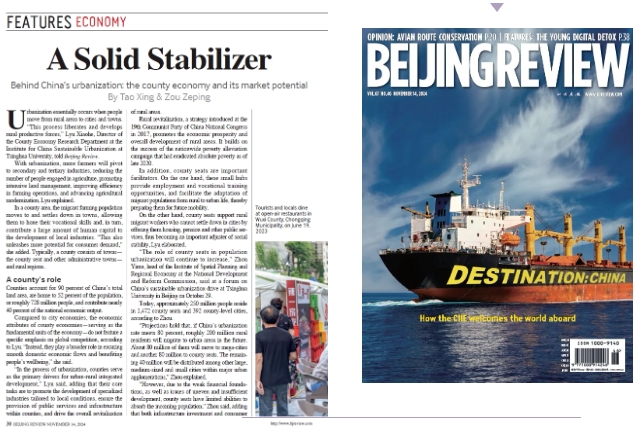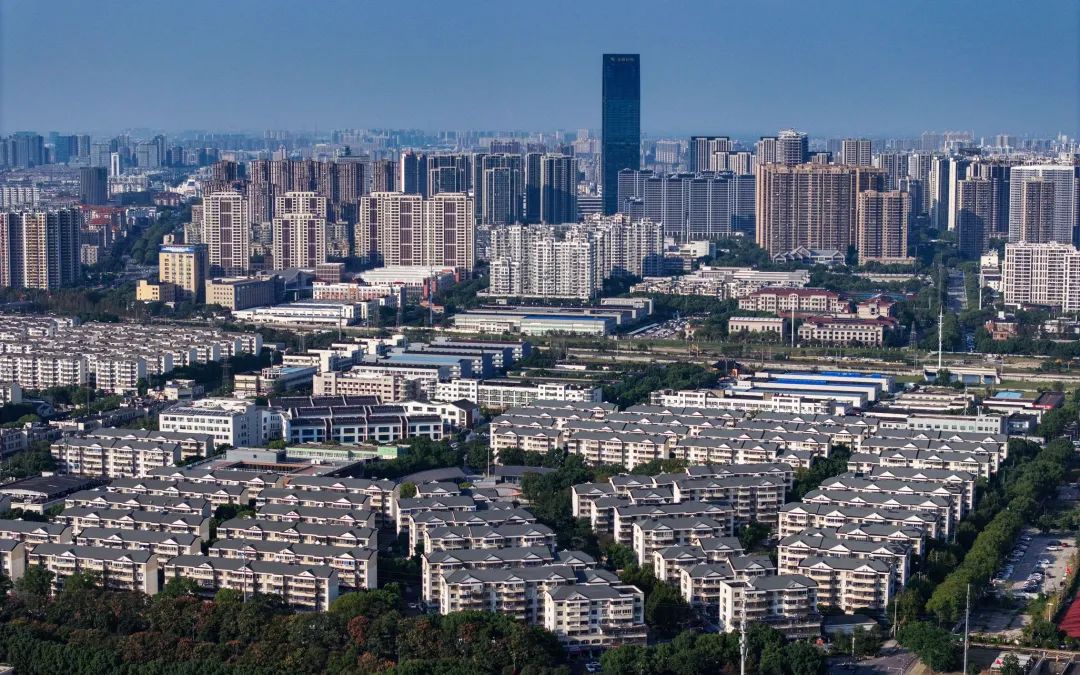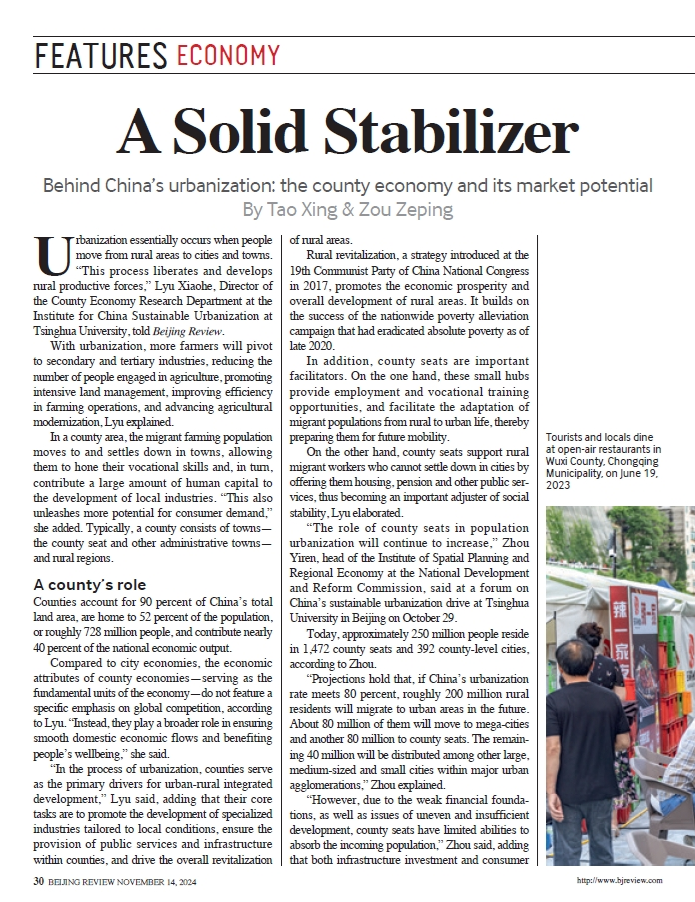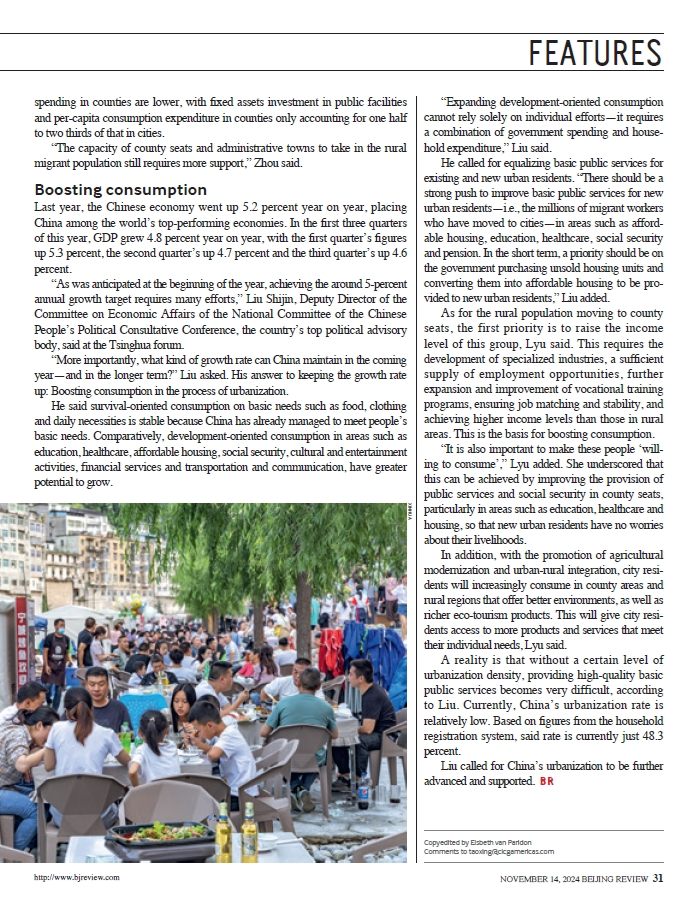
县域经济是我国经济发展的压舱石、稳定器。新型城镇化“下半场”,县域经济潜力巨大。最新一期《北京周报》(BEIJING REVIEW) 就此推出专题文章“A Solid Stabilizer|Behind China's urbanization: the county economy and its market potential”,专访了清华大学中国新型城镇化研究院县域经济研究部主任吕晓荷;并报道了本届“中国新型城镇化理论·政策·实践论坛2024”上,第十三届全国政协经济委员会副主任、国务院发展研究中心原副主任刘世锦,国家发展改革委国土开发与地区经济研究所所长周毅仁,在主旨演讲中提及的城镇化和县域发展的相关观点。
来源:《北京周报》(BEIJING REVIEW) 2024年11月14日第46期
作者:北京周报记者 陶幸
A Solid Stabilizer
Behind China's urbanization: the county economy and its market potential
Urbanization essentially occurs when people move from rural areas to cities and towns. "This process liberates and develops rural productive forces," Lyu Xiaohe, Director of the County Economy Research Department at the Institute for China Sustainable Urbanization at Tsinghua University, told Beijing Review.
With urbanization, more farmers will pivot to secondary and tertiary industries, reducing the number of people engaged in agriculture, promoting intensive land management, improving efficiency in farming operations, and advancing agricultural modernization, Lyu explained.
In a county area, the migrant farming population moves to and settles down in towns, allowing them to hone their vocational skills and, in turn, contribute a large amount of human capital to the development of local industries. "This also unleashes more potential for consumer demand," she added. Typically, a county consists of towns—the county seat and other administrative towns—and rural regions.

江苏昆山连续20年位居全国综合实力百强县榜首。图为昆山城区。新华社记者 李博 摄
01 A county's role
Counties account for 90 percent of China's total land area, are home to 52 percent of the population, or roughly 728 million people, and contribute nearly 40 percent of the national economic output.
Compared to city economies, the economic attributes of county economies—serving as the fundamental units of the economy—do not feature a specific emphasis on global competition, according to Lyu. "Instead, they play a broader role in ensuring smooth domestic economic flows and benefiting people's wellbeing," she said.
"In the process of urbanization, counties serve as the primary drivers for urban-rural integrated development," Lyu said, adding that their core tasks are to promote the development of specialized industries tailored to local conditions, ensure the provision of public services and infrastructure within counties, and drive the overall revitalization of rural areas.
Rural revitalization, a strategy introduced at the 19th Communist Party of China National Congress in 2017, promotes the economic prosperity and overall development of rural areas. It builds on the success of the nationwide poverty alleviation campaign that had eradicated absolute poverty as of late 2020.
In addition, county seats are important facilitators. On the one hand, these small hubs provide employment and vocational training opportunities, and facilitate the adaptation of migrant populations from rural to urban life, thereby preparing them for future mobility.
On the other hand, county seats support rural migrant workers who cannot settle down in cities by offering them housing, pension and other public services, thus becoming an important adjuster of social stability, Lyu elaborated.
"The role of county seats in population urbanization will continue to increase," Zhou Yiren, head of the Institute of Spatial Planning and Regional Economy at the National Development and Reform Commission, said at a forum on China's sustainable urbanization drive at Tsinghua University in Beijing on October 29.
Today, approximately 250 million people reside in 1,472 county seats and 392 county-level cities, according to Zhou.
"Projections hold that, if China's urbanization rate meets 80 percent, roughly 200 million rural residents will migrate to urban areas in the future. About 80 million of them will move to mega-cities and another 80 million to county seats. The remaining 40 million will be distributed among other large, medium-sized and small cities within major urban agglomerations," Zhou explained.
"However, due to the weak financial foundations, as well as issues of uneven and insufficient development, county seats have limited abilities to absorb the incoming population," Zhou said, adding that both infrastructure investment and consumer spending in counties are lower, with fixed assets investment in public facilities and per-capita consumption expenditure in counties only accounting for one half to two thirds of that in cities.
"The capacity of county seats and administrative towns to take in the rural migrant population still requires more support," Zhou said.
02 Boosting consumption
Last year, the Chinese economy went up 5.2 percent year on year, placing China among the world's top-performing economies. In the first three quarters of this year, GDP grew 4.8 percent year on year, with the first quarter's figures up 5.3 percent, the second quarter's up 4.7 percent and the third quarter's up 4.6 percent.
"As was anticipated at the beginning of the year, achieving the around 5-percent annual growth target requires many efforts," Liu Shijin, Deputy Director of the Committee on Economic Affairs of the National Committee of the Chinese People's Political Consultative Conference, the country's top political advisory body, said at the Tsinghua forum.
"More importantly, what kind of growth rate can China maintain in the coming year—and in the longer term?" Liu asked. His answer to keeping the growth rate up: Boosting consumption in the process of urbanization.
He said survival-oriented consumption on basic needs such as food, clothing and daily necessities is stable because China has already managed to meet people's basic needs. Comparatively, development-oriented consumption in areas such as education, healthcare, affordable housing, social security, cultural and entertainment activities, financial services and transportation and communication, have greater potential to grow.
"Expanding development-oriented consumption cannot rely solely on individual efforts—it requires a combination of government spending and household expenditure," Liu said.
He called for equalizing basic public services for existing and new urban residents. "There should be a strong push to improve basic public services for new urban residents—i.e., the millions of migrant workers who have moved to cities—in areas such as affordable housing, education, healthcare, social security and pension. In the short term, a priority should be on the government purchasing unsold housing units and converting them into affordable housing to be provided to new urban residents," Liu added.
As for the rural population moving to county seats, the first priority is to raise the income level of this group, Lyu said. This requires the development of specialized industries, a sufficient supply of employment opportunities, further expansion and improvement of vocational training programs, ensuring job matching and stability, and achieving higher income levels than those in rural areas. This is the basis for boosting consumption.
"It is also important to make these people 'willing to consume'," Lyu added. She underscored that this can be achieved by improving the provision of public services and social security in county seats, particularly in areas such as education, healthcare and housing, so that new urban residents have no worries about their livelihoods.
In addition, with the promotion of agricultural modernization and urban-rural integration, city residents will increasingly consume in county areas and rural regions that offer better environments, as well as richer eco-tourism products. This will give city residents access to more products and services that meet their individual needs, Lyu said.
A reality is that without a certain level of urbanization density, providing high-quality basic public services becomes very difficult, according to Liu. Currently, China's urbanization rate is relatively low. Based on figures from the household registration system, said rate is currently just 48.3 percent.
Liu called for China's urbanization to be further advanced and supported.





